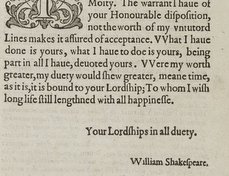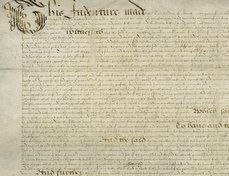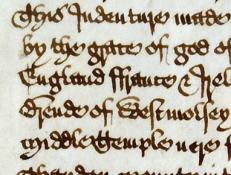Shakespeare Documented is still growing! Currently, two thirds of the descriptions and 98% of the images are available in the resource. Descriptive text will continue to be added, updated and expanded. Visit our About page to learn more about the project scope.
EXPLORE THE DOCUMENTS BY CATEGORY
SHAKESPEARE DOCUMENTED IS STILL GROWING
Descriptive content and transcriptions will continue to be added, updated and expanded. Check back for regular updates!
Filter the documents by tag(s)
circa 1623
In 1623, the antiquarian Sir Edward Dering turned the two parts of Henry IV into a single play, cutting 3000 lines from both. Dering’s adaptation is the earliest known manuscript copy, and first documented amateur performance of, a Shakespeare play (or rather, parts of two plays).
1623
The first collected edition of William Shakespeare’s plays is a celebrated volume known as the "First Folio." It is called a “Folio” because of the large-format size of the book.
November 8, 1623
The First Folio, which represents the first printed collection of 16 of Shakespeare’s plays, was entered into Liber D of the Stationers' Company on November 8, 1623.
August 8, 1623
Anne, William Shakespeare’s wife, was buried on August 8, 1623, according to the Holy Trinity Church parish register. Next to the entry, an “X” added by a later hand highlights its significance.
March 12, 1624
Dated March 12, 1623/4, this is the fifth of five enrolled indentures of bargain and sale for the Globe site, naming William Shakespeare as a leasee. The Globe playhouse was first built in 1599 on land leased from Sir Nicholas Brend.
Spring 1624
The principal book fair in Western Europe was held biannually in Frankfurt, Germany. While most books offered at the fair were in Latin, by 1618-1619 booksellers advertised books in English in printed catalogs.
January 9, 1624
Thomas Quiney, who married William Shakespeare’s daughter Judith in 1616, was elected a capital burgess on August 28, 1617 and served as constable for the years 1617/18, and 1618/19.
ca. 1625
In 1602 William Shakespeare negotiated with John Combe for the purchase of 107 acres for £320, a considerable sum.
1625
The antiquarian Richard James (1592-1638), fellow of Christ Church College, Oxford, explains in this dedicatory letter to Sir Henry Bourchier why Shakespeare changed the character originally named “Sir John Oldcastle” to one named “Sir John Falstaff” in Henry IV, Parts
ca. 1570- 1625
SHAKESPEARE DOCUMENTED IS STILL GROWING! Descriptive content and transcriptions will continue to be added, updated and expanded. Check back for regular updates!



















